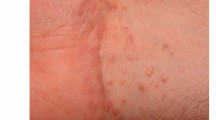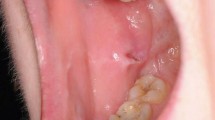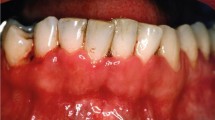Key Points
-
The number of individuals with syphilis — infection with Treponema pallidum — is increasing worldwide, including the UK.
-
A wide spectrum of oral lesions can arise at infective syphilis.
-
Oral ulceration is a common feature, and often the only clinical manifestation of infective syphilis.
Abstract
After many years the incidence of infective syphilis (infection with Treponema pallidum) is increasing in the United Kingdom. This may reflect changes in sexual attitudes and behaviour, altering trends in HIV disease, and increased foreign travel. Oral disease as a consequence of primary syphilis is rare. The present report details two patients presenting to an oral medicine clinic in London, within a 6-month period in 1999, with oral ulceration as their only clinical manifestation of undiagnosed primary syphilis. The oral aspects of early syphilis and the need for dentists to be aware of changing epidemiological trends in relevant infectious diseases are highlighted.
Similar content being viewed by others
Main
Infective syphilis is uncommon in the United Kingdom. In 1998 there were 132 recorded instances of primary and secondary syphilis in England and Wales.1 Nevertheless, following a steady decline in the number of reported cases of syphilis in England in the 1980s, the prevalence of infective syphilis has gradually increased since the mid-1990s,2 with the total number of new infections rising by 26% between 1996 and 1997.3 This epidemiological pattern follows a world-wide trend. The World Health Organisation (WHO) estimated 12.2 million new cases of syphilis in 1995, a figure significantly greater than the previous WHO global incidence estimates of 3.5 million new infections in 1990.4 Within some European countries (for example Russia), there has been an epidemic of syphilis among heterosexuals.5 These trends may reflect changes in sexual attitudes, outmoded penicillin regimes, political breakdown, paradoxical acceptability of sexually related disease and increased access to relevant clinics.6
In the UK, the greatest rise in syphilis has occurred in homosexual males, particularly in those aged over 30 years, who have had multiple sexual partners.7,8 However there have also been recent outbreaks of infective syphilis in heterosexuals, for example in Bristol in 1998.2
Syphilis gives rise to a wide spectrum of orofacial manifestations (Table 1), although there are few recent reports of the oral features of primary infection.9,10
The present report details the oral features of two male patients who presented with oral ulceration subsequently found to be their only manifestations of undiagnosed primary syphilis.
Case reports
Case 1
A 61-year-old Caucasian male was referred by his general dental practitioner to the Department of Oral Medicine of the Eastman Dental Institute for Oral Health Care Sciences for investigation of painful ulceration of the upper lip of 7 week's duration. The patient reported having lost 3 kg of weight in this same period. He attributed this to be secondary to the dysphagia caused by the painful oral ulceration.
Other than an acute icteric illness 20 years previously, his medical history was unremarkable.
The patient was homosexual and used barrier methods for the majority, but not all, episodes of oral and penetrative anal sex. Most of his sexual activity took place during frequent visits to India, the last being 9 weeks prior to presentation. The patient had stopped smoking 4 years previously and consumed 28 units of alcohol weekly.
Clinical examination revealed no cutaneous disease or cervical lymphadenopathy. Intra-orally there was a deep necrotic ulcer of 3 cm diameter with a narrow, erythematous non-rolled border on the upper left labial mucosa (Fig. 1). In addition, there were two small superficial oral ulcers on the floor of the mouth, an acute erythematous candidosis of the dorsum of the tongue and bilateral angular stomatitis.
The differential diagnosis, based on clinical findings, included HIV-related ulceration (including non-Hodgkin's lymphoma), primary syphilis, ulceration secondary to tuberculosis, chancroid or cytomegalovirus infection and squamous cell carcinoma.
Subsequent haematological, serological and histopathological investigations established primary infection with T. pallidum. The full blood cell count was normal (red and white cells, and platelets), and the differential white cell count revealed no abnormalities. Histopathological examination of an incisional biopsy of the lesional and perilesional tissue revealed only a chronic non-specific inflammation.
Following appropriate counselling, the patient was found to be HIV-negative. He did however have serological features of early T. pallidum infection. The Treponema pallidum haemagglutination and fluorescent treponeme assays (TPHA and FTA) were both positive, and the Rapid Plasma Reagin (RPR) had a high titre of 1 in 256.
After being informed of the diagnosis, the patient admitted to having had unprotected oral sex while in India. He also reported that he had had a previous episode of syphilis 30 years previously.
Detailed general medical examination and investigation including chest radiograph and electrocardiography failed to reveal any other stigmata of syphilis. Retrospective silver staining of lesional tissue did not reveal the local presence of spirochaetes.
The patient was treated with intramuscular benzathine benzyl penicillin (2.4 million units once weekly for 3 weeks). There was resolution of the ulceration 2 weeks after the penicillin therapy. The superficial ulcers had healed within 2 weeks of initial clinical presentation. Their cause remains unclear.
Case 2
A 31-year-old Caucasian male presented to the Department of Oral Medicine complaining of palatal ulceration posterior to the upper central incisors that had been present for 5 weeks. The ulceration was relatively painless but was sensitive to acidic foods. Subgingival scaling of the area, the local application of povidine-iodine 1% and chlorhexidine gluconate 0.2% mouthwash failed to improve the ulceration.
Review of the patient's past medical history revealed asthma exacerbated by exposure to cat fur, controlled by salbutamol and beclomethasone diproprionate inhalers, a tonsillectomy in 1993 and an episode of non-specific urethritis in 1997.
The patient was homosexual, with a long standing partner, but described an open relationship. He had been found to be HIV-negative 1 year previously and since then had practised safe penetrative anal sex, but used no precautions when having oral sex. He had recently returned from Mexico where he had had unprotected orogenital contact with several males. He reported drinking on average 10 units of alcohol a week and smoked 10 cigarettes daily.
On examination, there was no cervical lymphadenopathy. Intra-orally there was a 2 cm x 2 cm superficial ulcer of the mucosa and free gingiva palatal to the upper central incisors. The ulceration had a granular surface and was well demarcated (Fig. 2).
The differential diagnosis included primary and secondary syphilis, mucous membrane pemphigoid and non-Hodgkin's lymphoma.
Histopathological examination of lesional and perilesional tissue revealed an area of non-specific chronic inflammation. Direct immunofluorescence revealed no local deposits of IgG, IgA, IgM, C3 or fibrin. The full blood cell and differential white cell counts were normal. The patient had a positive RPR with a titre of 1 in 16, a positive FTA, but negative TPHA, confirming the diagnosis of syphilis.
The patient was referred to a genitourinary medicine clinic and found to have no other stigmata of infective syphilis. He was treated with daily intra-muscular procaine penicillin (procaine penicillin 900 mg, benzyl penicillin sodium 180 mg) for 10 days with oral probenicid (250 mg twice daily). The area of oral ulceration healed within 2 weeks of antimicrobial therapy.
Discussion
Infective syphilis is caused by the spirochaete Treponema pallidum. Transmission occurs via close contact with an infected lesion which usually occurs on the genitals.
Following contact, T. pallidum penetrates the genital or oral mucosa, multiplies at this site of entry, and systemically spreads via the lymphatics and blood. After an average incubation period of up to 90 days, a chancre develops at the site of inoculation. These ulcers may be solitary or multiple, and generally heal spontaneously without treatment within 3–8 weeks.
Extra-genital chancres arise in 12–14% of patients with primary syphilis.11 The oral mucosa is commonly affected as a consequence of orogenital contact.12,13,14 Chancres contain many viable treponemes, and are thus highly infectious. In men, oral chancres tend to arise on the upper lip, while in women, the lower lip is more commonly affected. The tongue, palate and nostrils are occasional sites of chancre development. Oral chancres usually manifest as painful, sometimes necrotic, ulcers associated with non-tender enlargement of the regional lymph nodes.15
T. pallidum can be identified in lesions by dark field microscopy or direct immunofluorescence, but usually serological confirmation is necessary. Currently employed diagnostic serologic tests for syphilis include those detecting antibodies to non-specific treponemal antigens — the Rapid Plasma Reagin (RPR) and Venereal Disease Research Laboratory (VDRL), and those detecting antibodies specific to T. pallidum — the T. pallidum haemagglutination assay (TPHA) and fluorescent treponema antibodies absorbed assay (FTA-Abs). The non-specific antibody tests are inexpensive, rapid screening tools and markers of disease activity. The specific tests are more sensitive than the non-specific assays — the FTA-Abs detecting antibodies to Treponema pallidum in the early stages of infection.16
The present two patients had oral chancres as a consequence of recent orogenital contact with other males, thus reflecting current epidemiological trends of infected syphilis in the UK. Both patients were unaware that sexually transmitted disease could result from orogenital contact, and hence had not used any barrier methods to limit infection transmission. Although there is an increasing prevalence of syphilis in the UK, it is interesting that both these patients appear to have acquired the infection in resource-poor countries. This is consistent with reported cases of infectious syphilis in England between 1994 and 1997, in which 54% of infections were acquired outside the UK.2 It is thus evident from the present report that a detailed social and sexually transmitted disease history should be carefully obtained from patients with unusual oral lesions.
The clinical features of the ulceration of patient 1 were similar to previous reports of a primary oral chancre.9,10 The second case while atypical of a primary chancre, was similar, but not identical, to those of the oral lesions which may accompany lue maligna in HIV-infected individuals.17 This atypical clinical presentation again emphasises the importance of obtaining a detailed history. Both patients had no other clinical features of syphilis, hence reflecting the knowledge that oral lesions can be the first and/or only features of significant infectious diseases.
Conclusion
The present report has highlighted the development of primary oral chancres in two patients. As the frequency of syphilis is rising world-wide, including the UK, it is important that British dentists are aware that syphilis remains of oral and dental relevance.
References
Public Health Laboratory Service Website. www.phls.co.uk/facts/syph-inf
GUM clinic returns on forms SBH60 (1971-1998 (Qtr 1)) and KC60 (198 (Qtr 2) to 1997). Selected diagnoses, by region and clinic, 1997. New diagnoses, selected conditions by sex: 1971 to 1997. PHLS AIDS & STD Centre and CDSC (Welsh Unit).
Hughes G, Simms I, Rogers P A, Swan A V, Catchpole M . New cases seen at genitourinary medicine clinics: England 1997. Communic Dis Rep CDR Supplement 1998; 8 (Suppl 7) S2–S11.
Gerbase A C, Rowley J T, Heymann D H L, Berkley S F B, Piot P . Global prevalence and incidence estimates of selected curable STDs. Sex Transm Inf 1998; 74 (Suppl 1) S12–S16.
Tichonova L, Borisenko K, Ward H, Meheus A, Gromyko A, Renton A . Epidemics of syphilis in the Russian Federation: trends, origins and priorities for control. Lancet 1997; 350: 210–213.
Thomas J C, Clark M, Robinson J, Monnett M, Kilmarx P H, Peterman T A . The social ecology of syphilis. Soc Sci Med 1999 Apr; 48: 1081–1094.
Mindel A, Tovey S J, Williams P . Primary and Secondary Syphilis, 20 years' experience. 1. Epidemiology. Genitourin Med 1987; 63: 361–364.
Williams L A, Klausner J D, Whittington W L H, Handsfield H H, Celum C, Holmes K K . Elimination and reintroduction of primary and secondary syphilis. Am J Public Health 1999; 89: 1093–1097.
Aloi F . Lip syphilitic chancre in a child. Pediatr Dermatol 1987; 4: 63.
Bhatt A P . Case of the month. Primary chancre of the lower lip. J Indian Dent Assoc 1986; 58: 1.
Neville B W, Damm D D, Allen C M, Bouquot J E . Oral and Maxillofacial Pathology. Philadelphia: WB Saunders Company, 1995: 146–149.
Laskaris G . Oral manifestations of infectious diseases. Den Clin North Am 1996; 40: 395–423.
Edwards S, Carne C . Oral sex and the transmission of non-viral STIs. Sex Transm Inf 1998; 74: 95–100.
Mindel A, Tovey S J, Williams P . Primary and Secondary Syphilis, 20 years' experience. 2. Clinical Features. Genitourin Med 1989; 65: 1–3.
Fiumara N J . Venereal diseases of the oral cavity. J Oral Med 1976; 31: 36–40, 55.
Young H . Syphilis serology. Dermatologic clinics 1998; 16: 691–698.
Ficarra F, Zaragoza A M, Stendardi L, Parri F, Cockerell C J . Early oral presentation of lues maligna in a patient with HIV infection. A case report. Oral Surg Oral Med Oral Pathol 1993; 75: 728–732.
Author information
Authors and Affiliations
Corresponding author
Additional information
Refereed Paper
Rights and permissions
About this article
Cite this article
Alam, F., Argiriadou, A., Hodgson, T. et al. Primary syphilis remains a cause of oral ulceration. Br Dent J 189, 352–354 (2000). https://doi.org/10.1038/sj.bdj.4800767
Received:
Accepted:
Published:
Issue Date:
DOI: https://doi.org/10.1038/sj.bdj.4800767
This article is cited by
-
Extragenital Chancre in Men Who Have Sex with Men: Six Cases from China
Archives of Sexual Behavior (2022)
-
Sonographic appearance of syphilitic induration mimicking squamous cell carcinoma in the lower lip: a case report
Journal of Medical Case Reports (2020)
-
The oral manifestations of syphilitic disease: a case report
Journal of Medical Case Reports (2019)
-
Ulcerated Lesions of the Oral Mucosa: Clinical and Histologic Review
Head and Neck Pathology (2019)
-
Angiomatoid fibrous histiocytoma on the hard palate: case report
Oral and Maxillofacial Surgery (2012)





